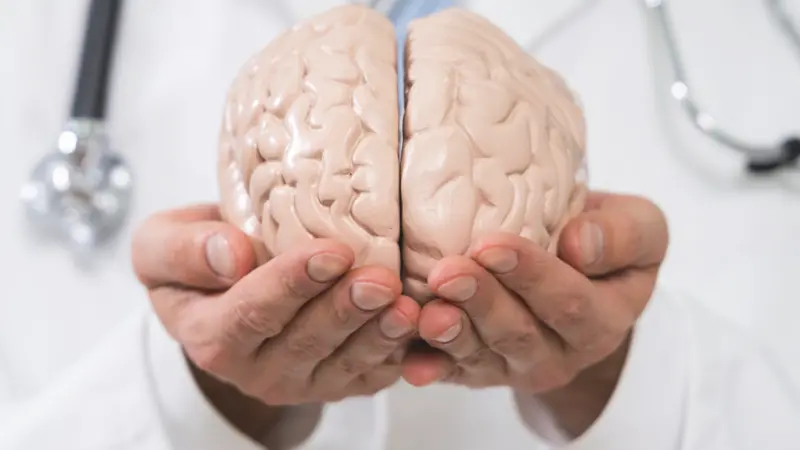

WELLthier Living and Aging

WELLthier Living and Aging
Nutritional Influences on Adult Neurogenesis
Abstract
The population of the United States is aging. In 2009 individuals aged 65 years or older numbered 39.6 million, representing 12.9% of the US population or about one in every eight Americans. It is estimated that by the year 2030, there will be about 72.1 million people over the age of 65. By comparison, in the year 2000, people 65 and older represented 12.4% of the population, but are expected to grow to about 19% of the population by 2030.1
Of all of the uncontrollable factors in our life, the process of aging may be the most daunting. To many of our citizens, synonymous with aging is the concept of universal and rapid cognitive decline. What may be encouraging is that while some memory loss may be a natural part of aging, researchers are discovering that it may be possible to help older people maintain more of their cognitive function well into later years. The longstanding belief that adults cannot generate new brain cells has been challenged by many biologists including Dr. Elizabeth Gould and Dr. Charles G. Gross at Princeton University who have found that thousands of freshly born neurons arrive each day in the cerebral cortex, the outer rind of the brain where higher intellectual functions and personality are centered.2
Though most of the research was performed on monkeys, purportedly the findings are believed to correlate to humans as well. If so, several experts have stated that it may reverse ideas about how the human brain works and open new possibilities for treating degenerative brain diseases.IBID
The goal of this paper is to demonstrate that those individuals compliantly following positive lifestyle factors will possess a greater capacity for neuroplasticity, dendritic generation, and even the growth of new neurons (neurogenesis). Elements such as continued mental stimulation, physical proprioceptive exercise, increased social interaction will be briefly discussed; major emphasis, however, will be on diet modification, glycemic control, weight management, and the administration of specific brain-enhancing nutrients.
Keywords: Neurogenesis, neuroplasticity, neurodegeneration, mental agility
Introduction
Is it true that “you can’t teach an old dog new tricks?” Plato once wrote, “When a man grows old he can no more learn much than he can run much.” In reality dog trainers will tell you that you can teach old dogs a new trick or two. A 2009 National Institutes of Health–sponsored study found that nearly one-third of 2,509 tested individuals over the age of 65 maintained cognitive function as they aged.3
Over the past two decades, the research devoted to the study of intelligence and neurological development has made a major contribution to the study of human cognition. In doing so, these fields have become increasingly intertwined. Comprehending the manner in which mental functioning undergoes its age-related physiological and pathological metamorphosis offers great promise for improving the lives of older citizens in the United States who, as previously stated, are a rapidly growing segment of the population.
Individuals compliantly following positive lifestyle factors will possess a greater capacity for neuroplasticity.
One such institution reacting to the escalating concerns relating to this inevitable generational transformation was the National Institute on Aging (NIA), which called for a “reappraisal of the research opportunities that would further our understanding of how cognition develops and changes with age” (statement of Ronald Abeles, NIA, to the National Research Council Board on Behavioral, Cognitive, and Sensory Sciences, August 11, 1998).4
In early 1999, the NIA made a request to the National Research Council (NRC) to assist in the evaluation of the field of cognition and memory in an aging population in order to help identify opportunistic areas of potential research that could substantially advance a foundational understanding. The intent was to draw upon recent developments in behavioral and cognitive science that may not have been previously fully applied to this subject area at the time.IBID
The preliminary indications have found that aging may contribute to some cognitive impairment, but can provide neuroprotective benefits in others. While it was previously believed that age-related cognitive decline was previously unavoidable, the most impressive discovery is that the human mind can be adaptive and flexible across the span of one’s life. To assist in this realm is the intervention of lifestyle initiatives that support brain function and inhibit neurological decay.
While this is not a treatise on dementia, more than five million Americans are believed to currently have Alzheimer’s disease, and by the year 2050, it is estimated that the number could reach 15 million.5 Additionally, the lifetime risk of Alzheimer’s disease among those who reached the age of 65 is approximately 1 in 5 for women and 1 in 10 among men.IBID The larger problem, however, is that we are on the threshold of a condition beyond dementia, senility, or Alzheimer’s. It is the state of age-related cognitive decline, lapse of memory, impaired mental performance, diminished enthusiasm, and dissolution of spirit. The good news is that we now know that there really is something we can do to avert a purported statistical eventuality and the place to start is adherence to a sound nutritional plan supplemented with appropriate nutrients and the abstinence of mind-absconding habits.
The High Cost of Modernization
The alertness of the mind, the balance of mood, the consistency of energy and the degree of happiness is, more often than not, a consequence of what we consume. Physiologically we have evolved over millions of years adapting to changing climates, cataclysmic events, escalating pressures, atmospheric transitions, progressive industrialization and devitalization of our food supply. Our physical environment has been severely altered with the advent of some 10 million man-created chemicals, thousands of which have been added to our common household products, the water we drink, the air we breathe, and the food that we eat.
Our physical environment has been severely altered with the advent of some 10 million man-created chemicals.
In the last half century we have transcended our historical concept of time and space. What once took a week to accomplish, we now can do in less than a day; the distance that would take a day to travel now could be covered in about an hour; and the speed of information and communication is now instantaneous. Our world has become compressed and intertwined creating a global cross-culturalization, which adds additional strains on all of us. These factors along with the aberrant transgression of our dietary intake over the last 100 years may have significantly compromised our mental health, alertness, cognition, and the intrinsic attainment of joy. It is my contention that this errant pattern of genetically-modified, chemically-laden, over-refined, over-processed, and overabundant foods have negatively impacted our synaptic potential and only a radical redirection toward nutritional consciousness can reverse this trend.
The Age Wave
America is growing older. In 1900 life expectancy was 47; today, according to the Centers for Disease Control and Prevention, life expectancy is 78. “This shift to an older population is not a trend, but a social inevitability offering challenges and opportunities for which necessitates a change in ideological perspective,” according to noted gerontologist Kenneth Dychtwald, Ph.D. In 1991 I had accepted a position under the direction of Dr. Dychtwald, who had founded a company named Age Wave and authored a book bearing the same name. Dychtwald’s contention is that the negative connotation of aging is inaccurate. He believes that one of the contributing factors of our negative images of aging is because of our glorification of youth. “The image of youth as vigorous, powerful and sexy has as its shadow an image of older people as incompetent, inflexible, wedded to the past, non creative, sick and (mentally) slow,” cites Dychtwald.6
Contemporary research is showing that the adult brain has much greater capacity for plasticity than had previously believed. Evidence is mounting that elder adults may be capable of growing new dendrites and perhaps even new neurons.7 Most of the losses in mental capacity, it is believed, happen not because of aging, but to depression, drug interaction, lack of exercise, loneliness, disease, or nutritional deprivation.IBID On the other hand, positive effects on cognitive function have been reported with older people, in response to antioxidants and to behavioral interventions, such as exercise and mind training. These findings suggest that there are efficacious interventions available to improve cognitive functioning as we age.8
For the 76 million baby boomers, the Age Wave may break through some erroneous perceptions of “old age” as many aging Americans are resisting the traditional concepts of aging and are getting off the couch, participating in physical activities, engaging in continuing education courses, residing in active senior living communities, accepting volunteer positions and returning to the workforce. George Burns was quoted as saying, "If I knew I was going to live this long, I would have taken better care of myself." Maybe many of these newly arrived seniors were paying attention when George uttered those words.
The Neuron Assassins
It is estimated that there are approximately 100 billion neurons in the human brain. It is believed that the brain loses function as it ages because neurons become damaged due to a number of lifestyle and environmental factors. Consumption of tobacco products, refined flours, processed meats, deep-fried foods, liquid candy, artificial sweeteners, preservatives, chemically-laden foods, and rancid fats are some of the factors that allow errant biochemical reactions that contribute to inflammation, oxidative damage, and glycation that destroy, harm, or alter DNA.
Brain enhancement isn’t just about what we should eat; it’s also about what we shouldn’t eat. Our brain and nervous system consist of essential fats, protein, and phospholipids, all of which can become damaged by pro-oxidants, the body’s so-called nuclear waste.
George Burns was quoted as saying, “If I knew I was going to live this long, I would have taken better care of myself.”
Insipid convenience foods, an inadequate diet, and food sensitivities may appreciably cause deterioration and aging of the brain. Most Americans fuel their bodies with fast food, refined carbohydrates, trans fats, and sugar-laden foods. Additionally, those who believe that they are eating healthfully may not be taking into account that what they perceive as healthy choices are genetically-modified, irradiated, contaminated with pesticides, raised in toxic environments, or transported from areas where quality control is substandard.
Dr. Joel Fuhrman, an integrative physician in New Jersey who specializes in treating illness nutritionally and author of Fasting and Eating for Health has stated, “the frightening fact is that our American diet literally causes our brain to shrink by depriving it of necessary nutrients and oxygen over the course of our lives.” By consensus, many holistically oriented practitioners have identified those foods that present the greatest compromise to brain health. They include sugar, trans fatty acids, deep-fried foods, and heavily processed foods.
Sugar – Stanford Professor Gerald Reaven, one of the world experts on blood sugar problems, estimates that 25% of non-obese people have insulin resistance. This means that their bodies don’t respond normally to insulin. This creates a syndrome called dysglycemia, causing many uncomfortable symptoms including: irritability; insomnia; fatigue; dizziness; excessive sweating; poor concentration; blurred vision; depression; forgetfulness; excessive thirst; digestive disturbances; anxiety.
Additionally, sugar-laden and processed foods use up stores of vitamins and minerals without replenishing those lost. I call this syndrome “nutrient debt.” It is no different than working a laborious 40-hour work week and having the boss declare at the end of the week, “I’m sorry, we’re broke and there’s no money to pay your salary.” Excess sugars exhaust, for example, B vitamins that are vital for energy production and mental performance. Sugar can also adversely affect cellular pH, creating an interference with the body’s absorption of calcium and magnesium and may contribute to the depletion of such essential minerals as chromium and copper.
Dr. Carl Pfeiffer, founder of the Brain Bio Center at Princeton University, classified blood sugar dysregulation as one of the five main underlying factors contributing to such psychological disturbances as antisocial behavior, psychosis, aggressiveness, phobias, suicidal tendencies, and schizophrenia.9
Bad Fats – As rancid and excessive saturated fats are transported through the bloodstream to the delicate tissues of the brain, the brain cells become coated with a waxy buildup called amyloidal plaque, which has an inflammatory effect on brain tissue. Amyloidal plaque in these narrow blood vessels inhibit the natural flow of oxygen and nutrients to the brain, literally enabling brain cells to die and the mass of the brain to shrink. This inflammatory cascade is a primary contributor of brain aging, oxidative degeneration, and dementia.
Trans fats are a docosahexaenoic acid (DHA) mimicker. It takes up the same position in the brain cells of this essential fatty acid. DHA is the most abundant omega-3 fatty acid in the brain and retina. DHA comprises 40% of the polyunsaturated fatty acids (PUFAs) in the brain and 60% of the PUFAs in the retina. Fifty percent of the weight of a neuron's plasma membrane is composed of DHA. Of all the fatty acids, DHA has the largest effect on brain PUFA composition.10
DHA is found in three phospholipids: phosphatidylethanolamine, ethanolamine plasmalogens, and phosphatidylserine (PS). It modulates the carrier-mediated transport of choline, glycine, and taurine, the function of delayed rectifier potassium channels, and the response of rhodopsin contained in the synaptic vesicles, among many other functions. A DHA deficiency is associated with cognitive decline. PS controls apoptosis, and low DHA levels lower neural cell PS and increase neural cell death.11
As the brain is more than half fat, there is a real danger of these fats becoming oxidized, which can cause a chain reaction of damage to the essential fats attached to phospholipids in nerve-cell membranes.
Heavy Metal Toxicity - Brain tissue has an affinity for heavy metals such as lead, mercury, cadmium, arsenic, and other toxic elements. When heavy metals appear in the brain, they can interfere with your natural brain chemistry. This interference, over time, can accelerate the onset of cognitive decline, dementia or Alzheimer's.
Aluminum, for example, is an element that has been associated with Alzheimer's. Aluminum has been found in high levels in the brain of people who have died of Alzheimer's. There is evidence that aluminum toxicity is associated with the probability of developing Alzheimer's.12
Heavy metals are ubiquitous in our environment. Foods with refined flours contain aluminum; our water supply is often tainted with lead; much of our fish contain mercury; cadmium can be inhaled from second-hand smoke, paint pigments, or our water supply; and arsenic is prevalent in herbicides and pesticides.
Canned and processed foods, organ meats, and fish are major sources of heavy metal poisoning.
Canned and processed foods, organ meats, and fish are major sources of heavy metal poisoning.
The Brain in the Belly
It was once believed that our thoughts and emotions are performed by neurons in the brain. Thanks in part to Michael Gershon, M.D., author of The Second Brain: The Scientific Basis of Gut Instinct and a Groundbreaking New Understanding of Nervous Disorders and the Intestine, we now know that the digestive system contains over 100 million neurons and produces as many neurotransmitters as the brain. The gut, for example, produces two-thirds (or more) of our serotonin. Every time we eat something, a signal is sent to the brain because the gut and the brain are in permanent communication. This is why the right foods and nutrients can make a person happy, and the wrong ones can cause depression, anxiety, and neurosis.13 While not the first researcher to analyze the gut-brain connection, a field called neurogastroenterology, Dr. Gershon was instrumental, in his best-selling book, to demonstrate this distinct relationship.
In my own practice, I always look to the digestive system and the bowel in the course of my assessments of any mood or cognitive imbalance because “if the tummy ain't happy, the brain ain't either!”
The Nutritional Brain Essentials
According to Patrick Holford, founder of the Institute for Optimum Nutrition in London and director of the Food for Brain Foundation, there are five essential brain booster food groupings (the inclusion of anti-oxidants is my addition).14
- Complex Carbohydrates
- Essential Fatty Acids
- Phospholipids
- Amino Acids
- Anti-oxidants
- Mind-Enhancing Nutritional Supplements
Carbohydrates – Primary Nutrition for the Brain
The most essential nutrient for our brain and nervous system is glucose. Glucose, a monosaccharide, is the form of sugar that travels through the bloodstream fueling the mitochondrial furnaces responsible for brain power. Glucose is the only fuel normally used by brain cells. Neurons not being capable of storing glucose are thus dependent on the bloodstream to deliver a constant supply of this essential fuel.
According to Holford, “We are, in essence, solar powered.” Plants are used to supply with our primary fuel by collecting the Sun’s energy in the form of glucose. They absorb hydrogen and oxygen (H2O – water) from the soil and carbon and oxygen (CO2 – carbon dioxide) from the air and combine their atoms together using the Sun’s energy to make carbohydrate (COH). We take in and digest the carbohydrate from plants and convert it into glucose and deliver it to all of the cells or our body and brain.
The brain consumes more glucose than any other organ. In a sedentary day the brain can consume up to 40% of all the carbohydrate that is eaten. That is why one undergoing a stressful experience may experience hunger. If this need isn’t satisfied in a timely manner, a resultant fatigue, irritability, dizziness, anxiety, insomnia, excessive sweating, depression, problem concentrating, or blurred vision may ensue.
Blood glucose is obtained from carbohydrates: the starches and sugars you eat in the form of grains and legumes, fruits, and vegetables. (The only animal foods containing a significant amount of carbohydrates are dairy products.) An excessive amount of sugar or refined carbohydrates at one time, however, can actually deprive the brain of glucose causing a depletion of energy, compromising concentration, memory, and learning capacity. Mental activities require a great deal of energy.
Complex carbohydrates are a preferred source of fuel as they are like time-release capsules of sugar. Simple carbohydrates are more like an injection of sugar.
Complex carbohydrates are like speed bumps on a roadway, slowing down the flow of traffic. They tend to be in natural foods having long chains of sugar molecules (polysaccharides) that the liver gradually breaks down into the shorter glucose molecules the brain uses for fuel. In natural foods, the cell walls are made of cellulose fiber that resists digestion, slowing the breakdown and the subsequent release of sugars into the bloodstream, kind of like the way a time-release capsule works. When complex carbohydrates such as whole grains, brown rice, vegetables, beans, lentils, or most types of fruit are consumed, the body performs exactly as it’s designed. These foods are digested, deliberately releasing its potential energy gradually. In addition to fiber, the protein and healthy fats, contained in many nutritious natural foods, provide additional speed bumps, thus modulating the roller coaster effect on cognition and mood.
Conversely, simple carbohydrates enter the bloodstream virtually unabated. They are found in most processed or refined foods and some natural foods. These carbohydrates have short-chained sugar molecules, hence break apart quickly, entering the bloodstream quickly. Sugary foods such as high fructose corn syrup, fruit juices, and honey contain glucose that is absorbed directly through the stomach wall and rapidly released into the bloodstream, almost as quickly as if delivered by syringe, having a profound short-term effect on blood sugar levels.
Complex carbohydrates are a preferred source of fuel as they are like time-release capsules of sugar. Simple carbohydrates are more like an injection of sugar.
Research at the Massachusetts Institute of Technology (MIT) found a significant difference in IQ scores (25%) between children who consumed the highest levels of refined carbohydrates (top fifth) as opposed to those who consumed the least (lowest fifth).15 The consensus of the researchers was that a healthy low-glycemic diet may contribute to higher test scores, better cognitive production, and possibly accelerated intelligence quotient. In addition a 2001 study conducted by Professor David Benton at Swansea University in Wales found that in order to maximize mental performance one needs an even supply of glucose delivered to the brain. It was his belief that dips in blood sugar were associated with poor attention, poor memory, and aggressive behavior.16
Enhancing Your Fat Quotient (FQ)
Albert Einstein had considered fish to be brain food. Scores of scientific references have confirmed Einstein’s assertion that there are many health benefits of eating cold-water fish such as wild salmon, mackerel, herring, striped bass, rainbow trout, halibut, sardines, and fresh tuna. Among the key nutrients that science has identified that positively influence brain function, essential fatty acids (omega-3 and omega-6 fatty acids) are about the most studied.
In addition to essential fatty acids being required by every cell in the human body, the brain, being 60% fat, needs a sustained source of healthy fats to function at peak efficiency. As these fats are not manufactured within the body, it is vital to obtain the necessary quantity from our diets to avoid serious deficiency states. These essential fats have been found to be critical for mental, immune, and cardiovascular health, and deficiencies have been associated with depression, cognitive decline, memory loss, dyslexia, attention deficit, mental fatigue, and Alzheimer’s disease.
While some fats, such as saturated and trans fats, may impair mental health, today vast numbers of scientists and medical authorities agree that a higher consumption of omega-3 fatty acids have demonstrated decreased inflammation, reduced incidence of fatal heart attacks, autoimmune disease suppression, as well as profound improvements in cognitive function and age-associated brain cell degeneration. This is based on copious numbers of well-conducted studies in both animals and humans.17
The omega-3 fatty acids that the brain and immune system really require are known as docosahexaenic acid (DHA) and eicosapentaenoic acid (EPA). The most researched sources of DHA and EPA are fish oils; however new research on algal sources has shown benefit (see below). DHA is especially important in brain and nervous system function, as it comprises 25% of the total human brain, especially the cell membrane. Most importantly, DHA is required by areas of the brain responsible for judgement and the ability to stay focused.
In studies in Chicago18 and Rotterdam19, researchers reported a 60% reduction in the incidence of Alzheimer’s disease among those eating as little as one cold-water fish meal per week. Specifically, in the Chicago study, the DHA component exerted the most protective cognitive effect, while the EPA component didn’t reveal any profound benefit. Additionally, the plant-derived omega-3 fatty acid, alpha linolenic acid, was also associated with a reduction in the risk of Alzheimer’s disease in subjects carrying the APOE4 gene, which is a powerful indicator of the disease.18
Those diagnosed with Alzheimer’s have been shown to have dramatically lower levels of DHA in the neurons of their hippocampus, an area of the brain most severely affected from the disease.20 DHA supplementation has been affirmed to improve memory in Alzheimer’s patients, as well as enhancing age-related memory loss.21
Furthermore, a myriad of animal studies, both mice and non-human primates, demonstrated that DHA-depleted diets have impaired learning and memory. These impairments were shown to be reversed after implementation of a diet high in DHA.22 An additional test revealed that feeding rats of all ages diets high in DHA had improved both short-term memory and long-term memory.IBID
According to board-certified neurologist David Perlmutter, M.D., DHA is “absolutely critical for a well functioning brain.”23 “The brain degenerates when it is inflamed and DHA is nature’s anti-inflammatory,” said Perlmutter, who believes that DHA may interfere with the formation of amyloid plaque* and can “kick-start the process of neurogenesis in the brain’s memory center.”
(*a starchlike protein-carbohydrate complex deposited abnormally in some tissues during certain chronic disease states, such as amyloidosis, rheumatoid arthritis, tuberculosis, and Alzheimer's disease. Stedman’s Medical Dictionary, 24th ed.)
A July 2009 study, presented at the International Conference on Alzheimer’s Disease, meeting in Vienna, Austria, of 485 healthy adults with mild memory complaints found that those who supplemented with 900 mg per day of algal DHA for six months made significantly fewer errors on memory tests than they had at the onset of the study.
The study, funded by Martek Biosciences, reported, “In our study, healthy people with memory complaints who took algal DHA capsules for six months had almost double the reduction in errors on a test that measured learning and memory performance versus those who took a placebo,” said Yurko-Mauro, PhD, associate director of clinical research at Martek and lead researcher of the study. He further stated, “The benefit is roughly equivalent to having the learning and memory skills of someone three years younger.”24
Interestingly, contrary to DHA’s reported benefits, once one has been beset with serious dementia, DHA has demonstrated little impact on cognition.IBID “In essence,” says Perlmutter, “you have to fix the roof while the sun is still shining.” Perlmutter recommends daily supplementation of 600 to 800 mg of DHA.23
The mechanism of action of omega-3 fatty acids, especially DHA, is that they are transported through cell membranes which regulate their entry into the cells that allow cell to cell communication. Thousands of specialized molecules called cell signaling molecules control not only the cell’s internal communication with the outside, but also the communication within the cell. These “special molecules” allow cells to communicate with the genes as well.25 The figure below (figure 1) taken from the January 2008 issue of Life Extension Magazine, depicts the assortment of cell signaling functions, such as cellular energy up-regulation via the mitochondria, gene activation, special protein generation, ion regulatory factors, and the inhibition of inflammatory mediators. These are very specialized and tightly regulated activities controlled by these cell-signaling molecules. DHA facilitates the enzymatic reactions enabling energy activation and proinflammatory mediation, which present neuroprotective and anti-inflammatory effects on the brain and nervous system, thus enhancing neuronal growth and cellular communication (neurogenesis) (see figure 2).
Source: Life Extension Magazine, January 2008.
Source: Life Extension Magazine, January 2008.
Phospholipids – The Super Brain Builders
Phospholipids are called the “insulation experts” as they comprise a significant portion of the myelin that insulates all of the nerves and enhances neuronal communication. Phospholipids also assist the manufacture of acetylcholine, the neurotransmitter that controls memory, as well as enhancing the body process of methylation, which is how the body and brain keep the thousands of biochemicals and neurotransmitters in balance.
Phospholipids belong to a class of phosphate-containing lipids. Additionally, phospholipids contain a nitrogen compound such as serine or choline, or a carbohydrate-like molecule, inositol. The body can manufacture its own phospholipids. Food sources include eggs, organ meats, lean meats, fish, shellfish, cereal grains, and oilseeds. The best-known phospholipid is lecithin (taken from “lekithos” the Greek word for egg yolk), an important building block of cell membranes and a transport mechanism for lipids and soluble vitamins.
According to Dr. Richard Wurtman of the Massachusetts Institute of Technology, “If your choline levels are depleted, the body will grab the choline the body needs for building nerve cells in order to make more acetylcholine.” Hence, Wurtman believes, providing the brain with enough of this nutrient would be an essential means for preventing brain damage.26
A 1993 study of 80 college students who were given a dose of 25 grams of phosphatidylcholine demonstrated a significant improvement of memory within 90 minutes of consumption. It was especially apparent among those students considered slow learners.27 Because acetylcholine, the memory neurotransmitter, is formulated directly from choline, one could surmise that a deficiency would most probably be the single most common cause of diminishing memory.
Phosphatidylcholine is also an important nutrient in keeping homocysteine levels stable. An elevation in blood levels of homocysteine is a marker for a number of cardiovascular and neurological degenerative diseases. Choline is an essential component of the phospholipid cycle, enhancing a process called methylation. This process is a critical factor in determining optimum mental health, enhanced concentration, mood, and resistance to stress. This is how the body maintains the balance of thousands of neurotransmitters, hormones, and other essential biochemicals. Faulty methylation is linked to mood disturbances, memory loss, and aberrant thinking.
Another brain-boosting phospholipid is phosphatidylserine (PS). PS is a biological substance that occurs naturally throughout every cell in the body. According to internationally recognized nutrition scientist Parris Kidd, PhD, “PS when added to the daily diet as a supplemental nutrient concentrate, can have great benefits for the brain.”28
PS is not considered a vitamin as it can be synthesized (biosynthesis) within the body. This process, however, of PS biosynthesis is quite energy inefficient, whereas obtaining PS through supplementation is far more efficient. (Note: there aren’t any food sources that contain ample quantities of PS.)
A 1993 study of 80 college students who were given a dose of 25 grams of phosphatidylcholine demonstrated a significant improvement of memory within 90 minutes of consumption.
According to Dr. Kidd, over the last 20 years, PS has been subjected to at least 21 double-blind clinical trials demonstrating significant benefits without any evidence of negative effects.
These clinical benefits include:29
- Improvements in memory, learning and other cognitive functions in people who are substantially impaired compared to others in the same age group
- Improvement in activities in daily living (ADL) and other aspects of quality of life, especially in people suffering severe memory loss
- Improvement in mood and incidence of anxiety (all age groups)
- Has demonstrated the potential of aiding children with attention and behavioral difficulties
The FDA approved health claims for phosphatidylserine include:30
“Phosphatidylserine (PS) may reduce the risk of cognitive dysfunction in the elderly. Very limited and preliminary scientific research suggests that PS may reduce the risk of cognitive dysfunction in the elderly. FDA concludes that there is little scientific evidence supporting this claim.”
“Phosphatidylserine (PS) may reduce the risk of dementia in the elderly. Very limited and preliminary scientific research suggests that PS may reduce the risk of dementia in the elderly. FDA concludes that there is little scientific evidence supporting this claim.”
Parris Kidd recommends a supplementation range from 100 to 300 mg per day.
A relative newcomer in the mind-boosting supplement field is alpha glycerophosphocholine (Alpha GPC). Alpha GPC is a phospholipid metabolite, related to choline and lecithin. It is a protective orthomolecular nutrient for the brain, kidneys, muscles, testes, and other organs and a building block for cell membrane phospholipids. Alpha GPC is found concentrated in the neuronal membranes and is extremely well absorbed as it easily crosses the blood brain barrier, supporting brain function and learning processes by directly increasing the synthesis and secretion of acetylcholine. According to popular physician and medical writer, Ray Sahelian, M.D., alpha GPC is reported to protect neurons and improve signal transmission by serving as a precursor to membrane phospholipids.31
In addition to the aforementioned clinical applications, alpha GPC has also demonstrated benefits in non-clinical settings including:31, 34
- Memory enhancement
- Improvements in cognitive ability
- Expedited recovery time in head injury patients
- Augmented attention span
- Enhanced mental and physical performance among healthy individuals
- Sustained strength and endurance during workouts
- Improved liver and brain function
Coordination alpha GPC has a natural presence in all the body’s cells making it an orthomolecule.32 Orthomolecules, according to Nobel Laureate Linus Pauling, are those nutrients native to the body’s natural biochemical functions. His contention was that they are generally safer and more clinically versatile than other nutrients. This special nutritional status is the basis that purports to explain why alpha GPC is considered highly effective and safe as a dietary supplement. It is readily absorbed by mouth and is a major metabolic precursor for phosphatidylcholine (PC), the most common phospholipid of the nerve cell membranes. Alpha GPC is also the most bioavailable source of the essential nutrient choline. It is also a major source of choline in human mother's milk.
In a study performed by the Institute of Internal Medicine and Geriatrics, University of Palermo, Italy, and reported in the Annals of the New York Academy of Sciences in 1994, the clinical efficacy and the tolerability of alpha GPC was tested in a multicenter trial of 2,044 patients suffering from recent stroke or transient ischemic attacks. Alpha GPC was administered intramuscularly after the attack at the daily dose of 1000 mg for 28 days (first phase), then orally at the dose of 400 mg three times a day during the following five months after the first phase. The trial confirmed the therapeutic efficacy of alpha GPC on the cognitive recovery of patients with acute stroke or TIA, with a low percentage (2%) of adverse events confirming its excellent tolerability.33
Alpha GPC, according to Parris Kidd, has been tested in a number of controlled clinical trials among subjects aged 50 and older suffering from memory and cognitive decline. In all of the trials, states Kidd, alpha GPC has shown measurable benefit. Alpha GPC even outperformed several “smart drugs” in head-to-head controlled clinical trials.34 Scores of studies have been cited in Parris’ book GPC (GlyceroPhosphoCholine): Mind-Body Power for Active Living and Healthy Aging (2007).
The dosages that were used in most clinical studies were in the area of 600-1200 mg per day. These dosages were used therapeutically to treat neurological impairments and initial stages of cognitive decline. Daily average maintenance dosages, according to a few nutritional suppliers (Douglas, Designs for Health and Life Extension), have been determined to be in the range of 300 to 600 mg.
Part One Conclusion
Exciting new research has yielded many breakthroughs in our understanding of how the mind ages. We now know that cognitive decline may depend less on the loss of brain cells than on changes in the health and efficiency of the surviving neurons and their networks. Research has revealed that the ability to thwart cognitive decline is a complex and multi-faceted process including many lifestyle, behavioral, social, and nutritive applications. No single modality can surmount the efficacy of maintaining a balanced, holistic approach in sustaining mental rejuvenation. The mind is not the brain. As our body degenerates, so does the essence of the mind. Believing that one merely needs to support brain physiology for robust mental health is tantamount to asserting that an engine is all that is necessary to run a car.
The mind needs a variety of stimulants in balanced amounts rather than any one factor in isolation. While we often opt for that magic bullet that is going to cure all of our ills, our physiology is too complex with a myriad of biochemical needs. It is important to note that nutritional interventions, while an essential element in protecting and enhancing our life-long cognitive capacity, is not an end-all. In combination, however, with physical exercise, strong social networks, a passionate sense of purpose, and continued mental stimulation, it is eminently possible to preserve mental capacity well into our eighth and ninth decades of life.
This is a first part of a comprehensive review of nutritional interventions related to neurogenesis. The next section will focus on the importance of certain amino acids, anti-oxidants, and specific mind-enhancing nutrients.
REFERENCES
1. Administration on Aging, www.aoa.gov. Last modified 6/30/2010.
2. Gould E, Reeves AJ, Graziano MS, and Gross CG. Neurogenesis in the neocortex of adult primates. Science 286: 548–552, 1999.
3. Yaffe K, Fiocco AJ, Lindquist K, Vittinghoff E, Simonsick EM, et al. Predictors of maintaining cognitive function in older adults. Neurology 72:2020-2035, 2009.
4. Abeles, R. Cognition in Context, National Institute on Aging, National Research Council Board on Behavioral, Cognitive, and Sensory Sciences, Rockville, MD, August 11, 1998 (conference notes).
5. Alzheimer’s Disease Research, A Program of the American Health Assistance Foundation. http://www.ahaf.org/alzheimers/about /understanding/facts.html.
6. Dychtwald, K. Age Wave, St. Martin’s Press, New York, NY, 1989.
7. Kolb, B., Whishaw, I.Q. Brain Plasticity and Behavior. Annual Review of Psychology, 49:43-64, 1998.
8. Jama, JW., Launer, LJ., Witteman, JC. Dietary Antioxidants and Cognitive Function in a Population-based Sample of Older Persons: The Rotterdam Study, American Journal of Epidemiology, 144:275-240, 1996.
9. Pfeiffer, C. Nutrition and Mental Illness: An Orthomolecular Approach to Balancing Body Chemistry, Healing Arts Press, Rochester, VT, 1988.
10. Youdim KA, Martin A, Joseph JA. Essential Fatty Acids and the Brain: Possible Health Implications, Journal of Developmental Neuroscience July/August 18(4-5):383-99, 2000.
11. Lukiw WJ, Cui JG, Marcheselli VL, et al. A role for docosahexaenoic acid-derived neuroprotectin D1 in neural cell survival and Alzheimer disease. Journal of Clinical Investigation, 115(10): 2774–83, 2005.
12. Miu, AC, Benga, O. Aluminum and Alzheimer’s: A New Look. Journal of Alzheimer’s Disease, 1387-2877 (10) 2-3, 2006.
13. Gershon, M. The Second Brain: The Scientific Basis of Gut Instinct and a Groundbreaking New Understanding of Nervous Disorders and the Intestine, Harper, New York, NY, 1998.
14. Holford, P. New Optimum Nutrition for the Mind, Basic Health Publications, Laguna Beach, CA, 2009.
15. Schauss, A. Nutrition and Behavior: Complex Interdisciplinary Research, Nutritional Health, 59(1-2)9-37, 1984.
16. Benton, D. The Impact of the Supply of Glucose to the Brain on Mood and Memory, Nutrition Review, 59(1-2)20-21, 2001.
17. Yehuda, S, Rabinovtz, S, Carasso, RL, Mostofsky, D. Essential Fatty Acids Preparation Improves Alzheimer’s Patients Quality of Life. International Journal of Neuroscience, Nov:87(3-4):141-9, 1996.
18. Morris, MC, Evans, DA, Bienias, JL, et al. Consumption of Fish and Omega-3 Fatty Acids and Risk of Incident Alzheimer Disease. Archives of Neurology, Jul:60(7):940-6, 2003.
19. Kalmijn, S, Launer, LJ, Ott, A, et al. Dietary Fat Intake and the Risk of Incident Dementia in the Rotterdam Study. Annals of Neurology, Nov:42(5):776-82, 1997.
20. Soderberg, M, Edlund, C, Kristensson, K, Dallner, G. Fatty Acid Composition of Brain Phospholipids in Aging and in Alzheimer’s Disease. Lipids, Jun:26(6):421-5, 1991.
21. Morris, MC, Evans, DA, Tangney, CC, Beinias, JL, Wilson, RS. Fish Consumption and Cognitive Decline with Age in a Large Community Study. Archives of Neurology, Dec:62(12):1849-52, 2005.
22. Gamoh, S, Hashimoto, M, Hossain, S, Masumura, S. Chronic Administration of Docosahexaenoic Acid Improves the Performance of Radial Arm Maze Tasks in Aged Rats. Clinical Experiments in Pharmacological Physiology, Apr:28(4):266-70, 2001.
23. Perlmutter, D. The Better Brain Book, Berkley Publishing Group, New York, NY, 2004.
24. Quinn, JF, Raman, R, Thomas, RG, Ernstrom, K, Yurko-Mauro, K, et al. A Clinical Trial of Docosahexaenic Acid (DHA) for the Treatment of Alzheimer’s Disease. Alzheimer’s Association 2009 International Conference on Alzheimer’s Disease in Vienna.
25. Blaylock, R. DHA Supports Brain Development and Protects Neurological Function. Life Extension Magazine, July:14(1):44-55, 2008.
26. Wurtman, R, Zeisel, S. Brain Choline: It’s Sources and Effects on the Synthesis and Release of Acetycholine. Aging, (19):303-13, 1982.
27. Ladd, S, et al. Effect of Phosphatidylcholine on Explicit Memory. Clinical Neuropharmacology, 16(6):540-9, 1993.
28. Kidd, P. PS (Phosphatidylserine): Nature’s Brain Booster. A Total Health Publication, St. George, UT, 2005.
29. Kidd, P. The Phospholipids as Anti-aging Nutraceuticals. In, Anti-aging Medical Therapeutics. Vol. 4, A4M Publications, Chicago, IL, 2009.
30. Klatz R, Godman R. American Academy of Anti-aging Medicine. 282-95, 2000. U.S. Food and Drug Administration Center for Food Safety and Applied Nutrition/ Office of Nutritional Products and Dietary Supplements. 19 Phosphatidylserine and Cognitive Dysfunction and Dementia (qualified health claim: final decision letter). May 13, 2003. www.cfsan.fda.gov.
31. www.raysahelian.com/alphagpc.html
32. Pauling, L. Orthomolecular Psychiatry. Science, 160:265-73, 1968.
33. Barbagallo Sangiorgi G, Barbagallo M, Giordano M, Meli M, Panzarasa R. Alpha-Glycerophosphocholine in the Mental Recovery of Cerebral Ischemic Attacks. An Italian Multicenter Clinical Trial. Annals New York Academy of Science Jun 30;717:253-69, 1994.
34. Kidd, P. GPC (GlyceroPhosphoCholine): Mind-Body Power for Active Living and Healthy Aging. A Total Health Publication, St. George, UT, 2007.


 By
By




